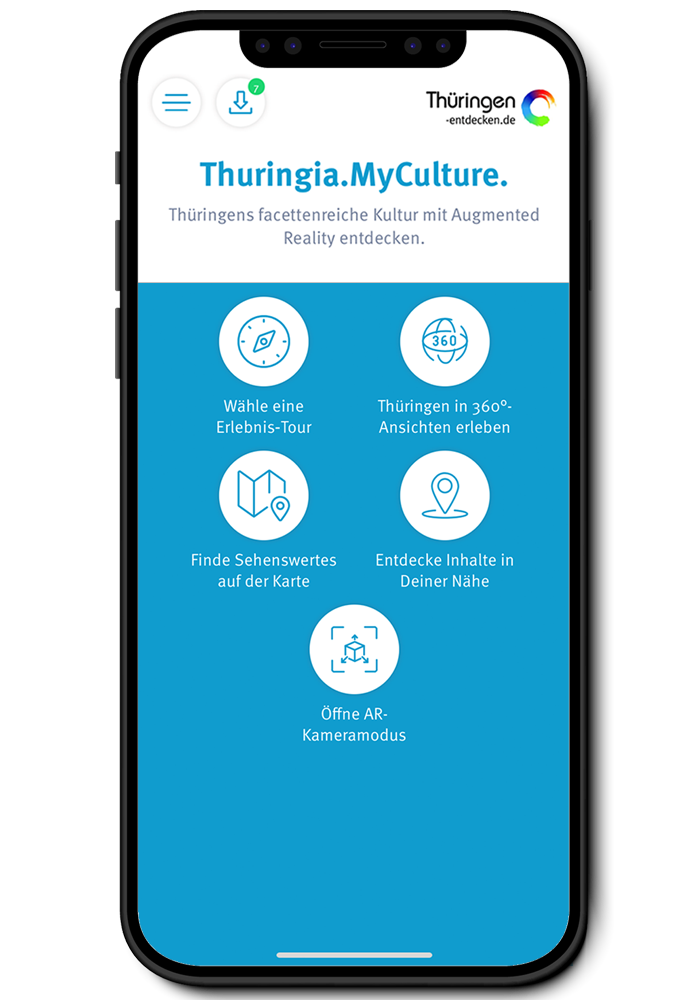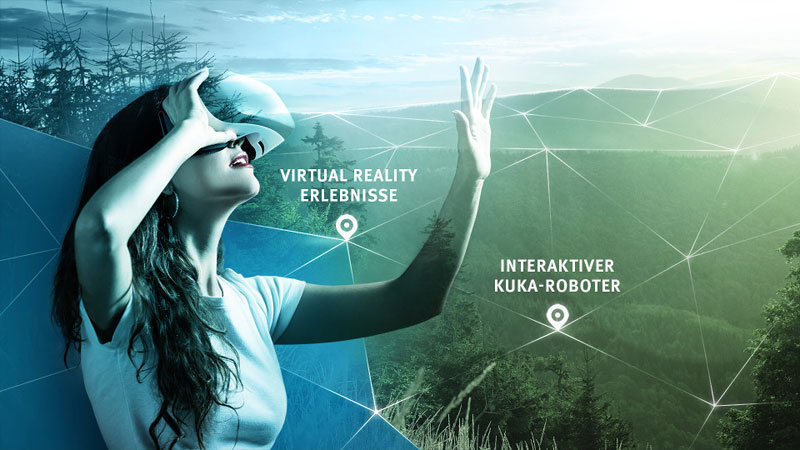Visit the state capital Erfurt and go on a virtual discovery tour through Thuringia.
Exciting insights as clear as glass
A Day in Lauscha
There is a lot to discover in Lauscha. That is why we are paying the tradition-steeped town a visit and taking you with us on our little trip. Together, we will seek out the most exciting experiences in Lauscha!
The Elias Glashütte – watching glass craftsmen live
Our trip takes us first to the Elias Glashütte. Even though Lauscha is already characterised by the historically significant glass industry, the glassworks stands out in its own way. It is one of the last commercially producing glassworks to provide its visitors with a deep insight into the work of the craftsmen – which it has done more than 160 years. We can look right over the shoulders of the craftsmen as they work and see vases, jugs or artificial flowers take shape before our very eyes – all made of environmentally friendly glass that is 100 % recyclable. As we watch, we clearly notice how much dedication and passion goes into a whole series of unique products and the relationship that the people on the spot have with glass as a material of sophisticated, artistic craftsmanship.
However, it is not only the craftsmanship per se that is deemed important as an artistic act in the glassworks – the glassworks also features another art form: theatre. Every day, the ELIAS theatre presents the glass legend of Elias Greiner Vetter’s son. According to legend, the glass marble was invented by Elias, who founded the Elias glassworks in 1853 in the wake of this invention. During the performance, Elias presents his fabulous journey through time and teaches us the historical circumstances of the glassworks in an extremely entertaining way. We leave the glassworks in wide-eyed wonder, with a lot of new impressions and a great deal of background knowledge, but stay on the same topic.
Glass decoration belongs to christmas time - and there is a lot to find of it in Lauscha. © Dominik Ketz, Regionalverbund Thüringer Wald
The glass museum in Lauscha – cultural heritage for everyone
Our next stop is the glass museum in Lauscha, which is no less impressive from a historical and contemporary perspective. The collection contains exhibits ranging from the late Middle Ages to the present day. Magnificent vessels, glass beads, glass eyes, Christmas tree ornaments – with its varied and extensive range, the institution is one of the oldest and most important municipal museums in Thuringia and consequently houses a key element of Thuringian cultural heritage. When we finally enter the building and buy our tickets, we are presented with a whole series of different impressions and a sense of the historical significance of the exhibits: so varied, but equally interesting.
The museum claims to have set itself the objective of continually putting the connection between the past and the present into context and making the logical steps in the development of the cultural history of glass art visible and transparent for everyone - extremely fascinating and worth seeing! Interesting people, fascinating historical facts and images of glass works of art that we will not be able to get out of our head for a long time – all of these can be seen in Lauscha’s glass museum.
The Glaszentrum Lauscha – where glass is still worked by hand
After we have left the museum again, we take a look at our schedule and head off for the next destination, which further underlines the significance that glass holds for Lauscha – the Glaszentrum Lauscha. Here we once again get the opportunity to discover glass in all its shapes and colours – over an area of 1,000 m² in three huts. From high-quality individual pieces to perfect home decorations, the glass centre has everything that your heart desires. Alongside a number of impressive exhibits, the focus here is primarily on witnessing the manual production process, and the Christmas workshop, which is open all year round, is particularly worth a mention. Here we can see manual glass craftsmanship up close and we gradually get the impression that traditional craftsmanship is the rule rather than the exception in Lauscha.
Eating and watching the craftsman work - you can do that at The Glaszentrum Lauscha. © Paul Hentschel Photography
After we have seen everything in the huts, we go to the adjoining restaurant and café, where we are warmly welcomed by the staff, to fortify ourselves for our next stops in Lauscha. The menu is centred around original Thuringian cuisine; the Thuringian tray bake cakes should be particularly highlighted at this point. However, it is not only food that we find here. The restaurant has an unusual feature: the integration of a glassblowing demonstration, allowing the patrons to witness glassblowing live and up close as they eat.
Andreas Tresselt’s glass studio – combination of tradition and modernity
The next stop leads us to a small, tranquil shop in the heart of Lauscha’s city centre. The name of the shop is emblazoned on the shop windows: “Glasatelier Tresselt”, along with the promise “Lauschaer Glas direkt vom Hersteller” (Lauscha glass direct from the manufacturer”. And it really does deliver on its promise. Andreas Tresselt works here. Since 1990, he has presented his glass studio to the national and international glass scene, and he was even able to win the Thuringian Glassblowers’ Guild’s designer award for his work in 2000.
When we enter his studio, Mr Tresselt greets us very warmly and shows us his extensive collection of products, which are enormously varied in terms of the artistic design. We get to see high-quality products that have been designed from solid coloured glass, e.g. glass animals, glass figures or flowers made of glass. Other works have been created from hollow glass, for example vases, bowls, liqueur glasses or carafes. Andreas Tresselt stresses the need to incorporate all the skills of traditional Lauscha glass craftsmanship into his work in order to not only represent existing developments, but also take features of modern designs into consideration in a creative way. The focus is not solely on serial production on the basis of old patterns; the glassblower is also happy to provide unique pieces for his clientèle on request. And these unique pieces are not necessarily created by Andreas Tresselt. The visitors have the opportunity to get involved and produce their own glass bauble. We are, of course, unable to pass up this opportunity and so we design our own glass bauble.
Into the glass studio we got a friendly invitation by Andreas Tresselt. @ Paul Hentschel Photography
Malstübchen Katrin Albrecht – picturesque landscapes on glass baubles
Someone else who has a close relationship with glass art in Lauscha is Katrin Albrecht, who also resides right in the city centre and has a painting studio there. We visit her during our trip and see inside her studio, including the impressive equipment. All kinds of glass baubles are waiting for us there – in all sizes, from small and medium to large and extra-large. We can also see glass bells, vases and tea light holders that Ms Albrecht has painted. She does not allow herself to be pinned down in terms of the subject. From beautiful winter landscapes and the depiction of animals to floral patterns, she accumulates a wide variety of themes in her artistic creations.
The glassblower trail (Glasbläserpfad) – on the trail of the past
With our visit to Katrin Albrecht, our day in Lauscha is slowly drawing to a close. We have just one more item on the agenda: the glassblower trail, which leads from Lauscha to Sonneberg. In the middle of the 19th century, the path was regarded as the shortest link between the two towns and was of enormous significance for the glassblowers. They used this route to transport their handmade products in panniers or special wooden racks to Sonneberg, where the sellers were already waiting for them. This route was extremely strenuous in the autumn and winter months in particular. Even after a railway line from Lauscha to Sonneberg was established, the glassblowers were forced to use the trail to transport their work, as the wage paid by the sellers was by no means sufficient to pay for a train ticket in addition to the cost of living. It was not until the 1950s that the situation relaxed and the workers were significantly better paid. The glassblower trail immediately lost its significance, but the 16.5 km long trail can still be walked by enthusiastic walkers.
This marks the end of our trip through Lauscha. We have gained a number of fascinating impressions and ideas. We were very impressed by the enthusiasm for the preservation of manual craftsmanship and traditional production processes.
You can find a lot more great offerings by reading the brochure of Thuringian Forest Christmas Tradition with some of the best tips for your trip into one of the most beautiful christimas regions. Create your perfect week related to your preferences, make your way into the exciting world of glass-made christmas decoration and spend a wonderful vacation time with great experiences at the famous Rennsteig.
Did you like this story?
Maybe, you'll like this too ...













